
By Ray Heisey, PE, RRC
Senior Consultant
Your metal roof is leaking, rusting, energy inefficient, poorly installed and/or damaged. Can your roof be repaired or are your options limited to a tear-off and replacement or an overlay? In this article we explore the key factors in evaluating the potential longevity and repairability of metal roofs.
Good quality, low slope standing seam metal roof materials, when properly installed, may provide 30 to 40 years of service life with minimal annual maintenance. Conversely, mediocre quality materials or a poorly executed installation may deliver a standing seam metal roof which leaks before the contractor completes the installation. The mediocre metal roof may require extensive and potentially expensive repairs, or even replacement, to correct the issues causing the leaks. How do you determine whether a metal roof can be repaired or may have to be replaced? Unfortunately, the age of the roof is not a definitive factor. Some standing seam metal roofs may need to be replaced within a short period after installation while other roofs will last decades with little to no annual maintenance performed.
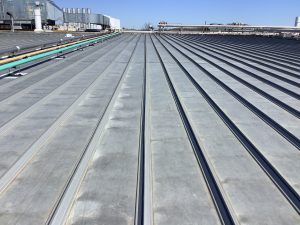
Change in direction at the line roof panel lap.
Let’s look at the factors that determine the potential longevity and repairability of a standing seam metal roof. A very important factor to the longevity of a metal roof is the alignment of the roof panels and other components during installation. The major corrugations or seams should be parallel and not have any changes in direction at end laps or transitions. If the ribs of the roof panels are not parallel for their full length and the roof panels ‘change direction’ at in-line end laps, roof movement is restricted and the components may not fit properly. Expansion and contraction movement, due to temperature differentials, can cause fasteners to back out at every panel misalignment. Once the roof panels are installed, correcting metal roof misalignment issues is not possible.
There should not be poor fit-up of any components manifested by large gaps between roof panels and/or flashings. If there are large gaps and spaces between the roof panels and flashings, sealing the defects may become a regular maintenance item for the life of the roof. The proper fit of the roof panels at end laps and the fit of other roof components is critical to maintain long-term weathertightness. A roof coating, with or without reinforcing fabric, is not the best solution to address poor alignment and fit-up of components. Roof coatings and topical sealants (applied to the surface) are a ‘band-aid’ and will not provide a long-term solution. Coating adhesion to the components and permeability of the coating are critical weaknesses leading to failure. If it is possible for proper repairs to be made to correct alignment and fit deficiencies, the repairs can be expensive and may not provide the desired longevity or watertightness as a properly installed roof.
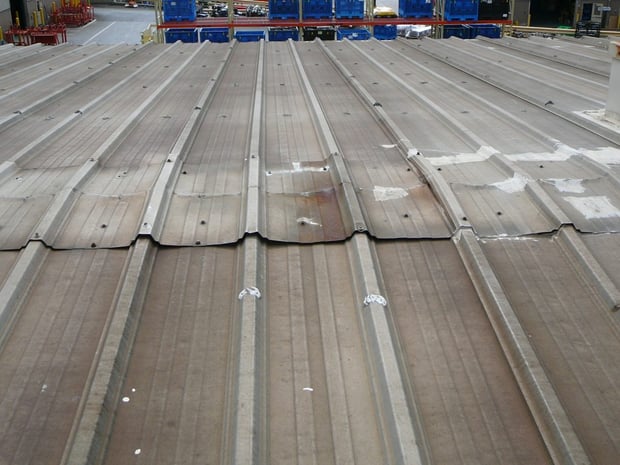
Bad fit-up at panel lap joint.
The condition of the sealants is another key factor to evaluate the potential longevity. All laps should be tight fitting and have a good waterproofing sealant in the joint. The manufacturer provided sealants that are installed at roof panel end laps, side laps, and flashings provide a weatherproof ‘gasket’ that prevents water and air infiltration. If a deficient installation produces poorly fit roof panels and other components, sealing large gaps and voids may not be possible for the originally installed butyl rubber sealant. Butyl rubber sealants are designed to stay flexible and to seal sheets of steel that are joined together with compression between the sheets. An eighth inch gap may not be properly sealed by eighth inch thick butyl tape sealant because the sealant cannot compress enough to fully adhere to both metal surfaces. Additionally, the gap may be large enough to allow ultraviolet light to degrade the sealant. Ultraviolet light will deteriorate butyl rubber sealant and cause drying, hardening, embrittlement, and cracking. Properly installed butyl rubber sealant must fully adhere to both metal surfaces to be sealed. If there is poor adhesion, a void, gap, or breach in the sealant, it may be possible for moisture to enter between the steel sheets.
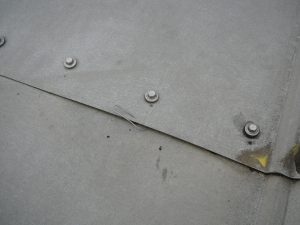
Wire probe detects no sealant at roof panel lap.
A non-invasive test for the presence of the butyl sealant ‘gasket’ in a sheet metal joint is to use a thin wire probe. When the probe is inserted into the sheet metal joint, intact sealant will provide resistance to the probe. After the probe is withdrawn the surface of the probe can be checked for tacky sealant residue. Intact and functional butyl rubber sealants will remain sticky or tacky, typically leaving residue which can be felt on a wire probe. Lack of contiguous sealant in a sheet metal lap can be a source of leaks through a metal roof.
If the roof installation is judged to be repairable, the proper repair for an unsealed sheet metal joint is to remove the fasteners, open the lap joint, remove the deteriorated or damaged butyl sealant, clean the joint to remove any dirt, and install a moisture curing polyurethane sealant along with new, slightly oversized fasteners.
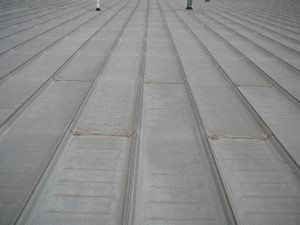
30+ year old Galvalume roof panel finish and staggered end laps.
Many other factors, including the selection of materials and design, can impact the longevity of a metal roof. A properly installed standing seam metal roof should have adequate slope to prevent retained (ponded) water anywhere on the roof. If roof panel end laps are present, they should be staggered and not adjacent to each other in a straight line. The roof panel side lap should be raised a minimum of two inches above the flat of the roof panels and the side lap seam should have a properly formed, mechanical seam, preferably a 360-degree Pittsburgh Double-Lock seam, the highest quality mechanically formed seam available.
Before extensive repairs are considered, the condition of the protective coating on the steel roof panels must also be evaluated. The protective coating on the steel roof panels is typically either Galvalume, an aluminum-zinc alloy hot dipped coating, or a baked-on paint finish over a primer over the metallic, Galvalume coating. In a non-corrosive environment, the Galvalume finish will last 30 to 40 years, depending on foot traffic and the amount of annual moisture (rain or snow). The sacrificial zinc in the Galvalume coating protects exposed steel at scratches or exposed cut edges from rusting. If the protective surface of the steel panels is intact and functioning properly to prevent rust, the roof may be worth the effort to repair .
When installation issues and alignment are not an issue, surface rusting on the roof panels and other sheet metal components can be stopped and the life of the roof can be extended. There are many paints and coating products marketed for use on rusting steel components. Many products require extensive surface preparation to perform successfully. The Uniflex 500 coating is an asphalt-based aluminum emulsion coating that sticks tenaciously to rusted steel with minimum surface preparation and can be warrantied for 15 years.
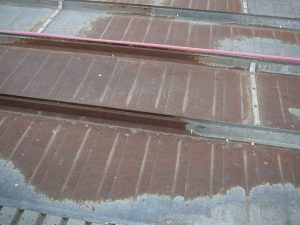
Surface rusted roof panels.
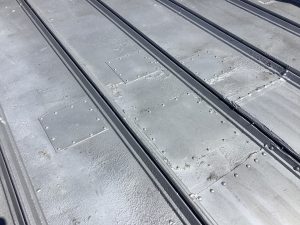
Uniflex 500 applied over roof panels and repairs.
Energy efficiency can be another key factor to evaluate the longevity of the roof system overall. Energy efficiency is primarily dependent on the R-value, which is based on the type and thickness of roof insulation. The lack of R-value can be addressed by adding insulation under the roof panels, between the secondary structural members, at the interior. Energy efficiency is secondarily based on the emissivity and reflectivity of the roof panels. Reflectivity and emissivity are properties of the metallic coating or paint finish on a metal roof panel. Reflectivity describes the ability of the coating or finish to reflect, not absorb, the solar radiation from the sun. Emissivity is how fast a material gives up the heat that it has absorbed. Reflectivity can be increased with a white paint or coating; however, it should be noted that paint and coatings will lose reflectivity over time as dirt is deposited and adheres to the roof surface.
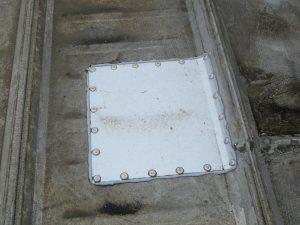
Metal patch at rust damaged panel.
When repairs are deemed an option to extend the service life of the metal roof, there are many methods available. In many cases, a damaged roof panel side lap seam can be addressed with a roof panel repair cap or a metal patch. Widespread damage across multiple roof panels may require cutting out the panels and installing new roof panels in the affected area. Damaged roof flashings and penetrations can be replaced by removing fasteners, installing new components with new sealant and installing new oversized fasteners. Most manufacturers provide repair methods and details for their specific roof system.
While defects in low slope single-ply membrane and asphalt roofs can be repaired by skilled craftsmen; a poor quality metal roof installation can be difficult, if not impossible, to correct and in many cases can only be effectively addressed with a roof replacement or roof overlay. Poor installation can be visually identified by: roof panels not in alignment; poor fit of roof panel laps, closures, and flashings; and large gaps between roof panels or flashings that the installed sealant cannot bridge or fill. When roof panels and other components are misaligned, topically applied sealants, roof coatings, and roof membrane are typically seen covering the problem locations. As noted above, the application of topical materials is a temporary fix, not a permanent correction of the original deficiency. Metal roof manufacturers do not specify topical sealants and roof coating materials in their roof installation guides. If the roof panels and related components are properly aligned, sealed and installed, topically applied corrective materials are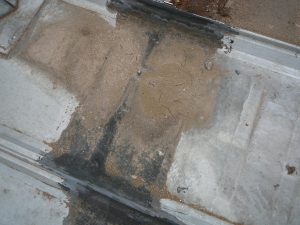 not recommended or necessary.
not recommended or necessary.
EPDM membrane patch over roof panel lap.
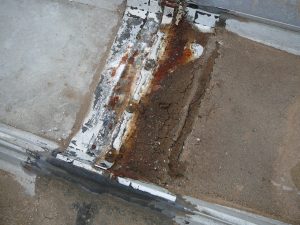
Removed EPDM membrane patch with evident rusting.
If you aren’t confident in your knowledge about the condition of your metal roof or ability to make a judgement or evaluate repair options, bring in an expert to inspect your roof and provide repair recommendations. If replacement is warranted, the expert will recommend that option rather than extensive, costly repairs that may only provide a few additional years of service life.
